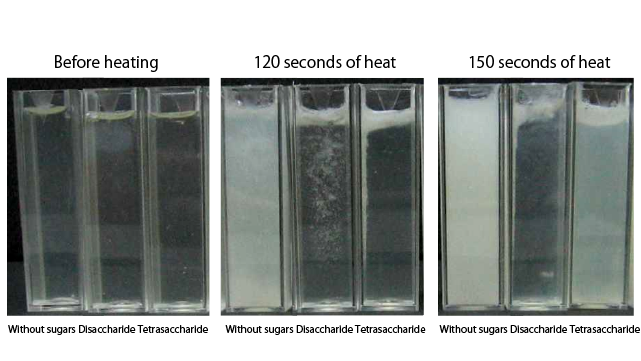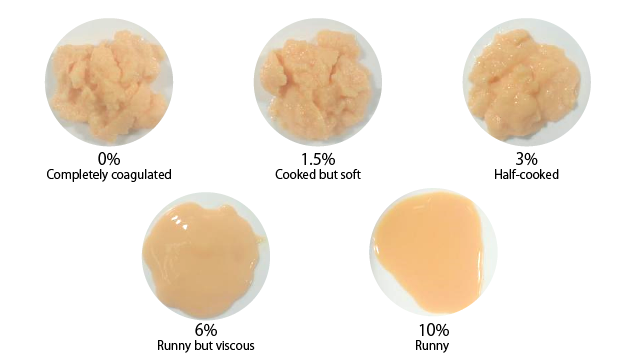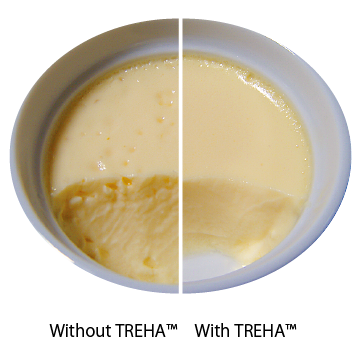News & Blogs
In this blog, we touch on diverse topics about Japanese food cultures, practices together with the culinary secret, TREHA®, and its important role in the Japanese food industry. We hope our blog helps you obtain in-depth knowledge of the secrets and science behind Japanese cuisine, shared from our kitchen, to yours.
Today’s topic on ‘Sugar 101’ is about how sugar influences protein coagulation.
When we heat raw protein (e.g. meat, fish, egg), the protein cooks and firms up. This process is called ‘protein coagulation’ or ‘protein denaturation’ and results in a more inflexible, whitish clump. Many kinds of food that we are familiar with are formed through protein coagulation, including meat patties and custard puddings.
When we cook food ingredients that contain protein with heat, protein coagulation occurs inside the food. Heating is a necessary step in food processing in many cases, however, excess protein coagulation may spoil the texture of the product. Some chefs use ‘low-temperature cooking’ methods to minimize protein coagulation and inhibit microbial growth. Although the ideal temperature for low-temperature cooking is about 58-68℃/135-155℉, chefs allow for a broader range of temperatures in the real world, as long as it is not boiling. We can enjoy the soft and juicy texture of protein by cooking at a low temperature. Understanding protein denaturation with heat is important to create tasty, high quality foods.
While chefs may control heating temperatures and texture of cooked protein when cooking, controlling protein coagulation in pastry and confectionery items is more challenging. Pastries and confectioneries need to be more stable than culinary creations in terms of storage, so they tend to be more thoroughly heated. To overcome this challenge, we can look to sugars to provide solutions.
We carried out experiments using egg whites, which are commonly used in pastries and confectioneries, and are easy to observe denaturation that occurs from heating.
Pic. 1 Egg whites with sugar: difference in coagulation with heating

Let’s see the effects of sugar on protein denaturation while heating. Pic.1 shows protein coagulation of egg whites while heating at 75℃/167℉. Boiling tubes are filled with egg whites, salt and sugar. Conditions are labeled below the tubes. A disaccharide consists of two mono-saccharides, such as glucose and fructose. Sucrose (table sugar) and trehalose (TREHA™; the tradename of trehalose manufactured by NFI) are common disaccharides used for culinary and confectionery making. A tetrasaccharide is a starch syrup, consisting of four mono-saccharides. Egg whites without sugar showed turbidity after heating for 120 seconds. Turbidity is caused by aggregation of proteins, denatured by heat. With sugar, it maintains its transparency, in particular, the disaccharide maintains the transparency of the egg white solution, even after heating for 150 seconds.
Pic. 2 Amount of TREHA™ and protein denaturation of liquid eggs

Let’s see the effect of sugar on the total amount of protein denaturation, using whole egg and TREHA™. Pic. 2 shows the amount of TREHA™ to liquid egg ratio, and coagulation after heating at 75℃/167℉for 6 minutes. As the percentage of TREHA™ increases, less protein is denatured. One of the important roles of sugar for pastry and confectionery making is to keep flexibility and softness of protein by raising the temperature of protein denaturation, which leads to processing suitability.
Sugar inhibits protein denaturation due to its ability to retain moisture; proteins become more stable when they are hydrated. When proteins are heated, water molecules which are bound to proteins are shaken and drawn away, and the structure of the protein changes. Sugar helps to retain water molecules bound to proteins, and inhibits protein denaturation caused by heat.
Moisture retention ability differs amongst different types of sugar. As shown by Pic.1, disaccharides have high moisture retention ability (=inhibit protein denaturation). To acquire a deeper understanding, we compared several types of disaccharides. We found that TREHA™ is one of the best disaccharides to inhibit protein denaturation. You may find commercial products using TREHA™ for this purpose. A custard pudding that melts-in-your-mouth, baked cheesecakes with a super-smooth texture, fried chicken sold in a hot showcase, and omelettes for microwave reheating – these are items which undergo significant heating conditions for proteins. TREHA™ may contribute to improving the quality of these items by inhibiting protein denaturation.

Mind the sugars for protein!
Now, you will understand the importance of sugars for food processing, especially pastry and confectionery making. Although low sweetness is one of the trends in recent years for pastry and confectionery, you need to be careful that your formulation contains enough sugar content. Imagine what would happen if you reduced sugar too much - your custard pudding or brûlée would become porous during the heating process, and coagulated before heat sterilization. Understanding sugar's properties including sweetness and physics is important to produce safe and tasty food products. For details about sweetness and the physical property of sugars, please visit Sugar 101 Lesson 2. Using science, we can take full advantage of sugar!
Pic. 3 Comparison of brûlée

Using TREHA™, the disaccharide that has a very high capacity to inhibit protein denaturation, makes crème brûlée smoother.
Thank you very much for reading our blog. Nagase Food Ingredients has the practical know-how for using sugar. Our experienced staff can help you to create and review your menus. Feel free to contact us.
Did you find this blog interesting?
Please share it with your friends in the food service industry.
We regularly update the blog about the food culture of Japan, where TREHA® was discovered for culinary applications.
Click here and send us a message to subscribe.
Or hit us up on Instagram @trehalose_sensei!

